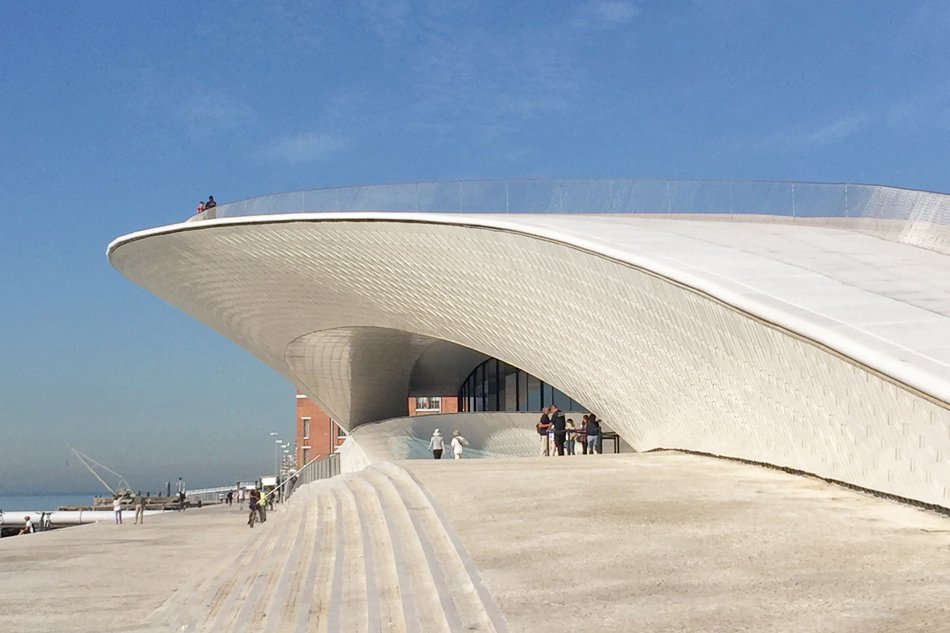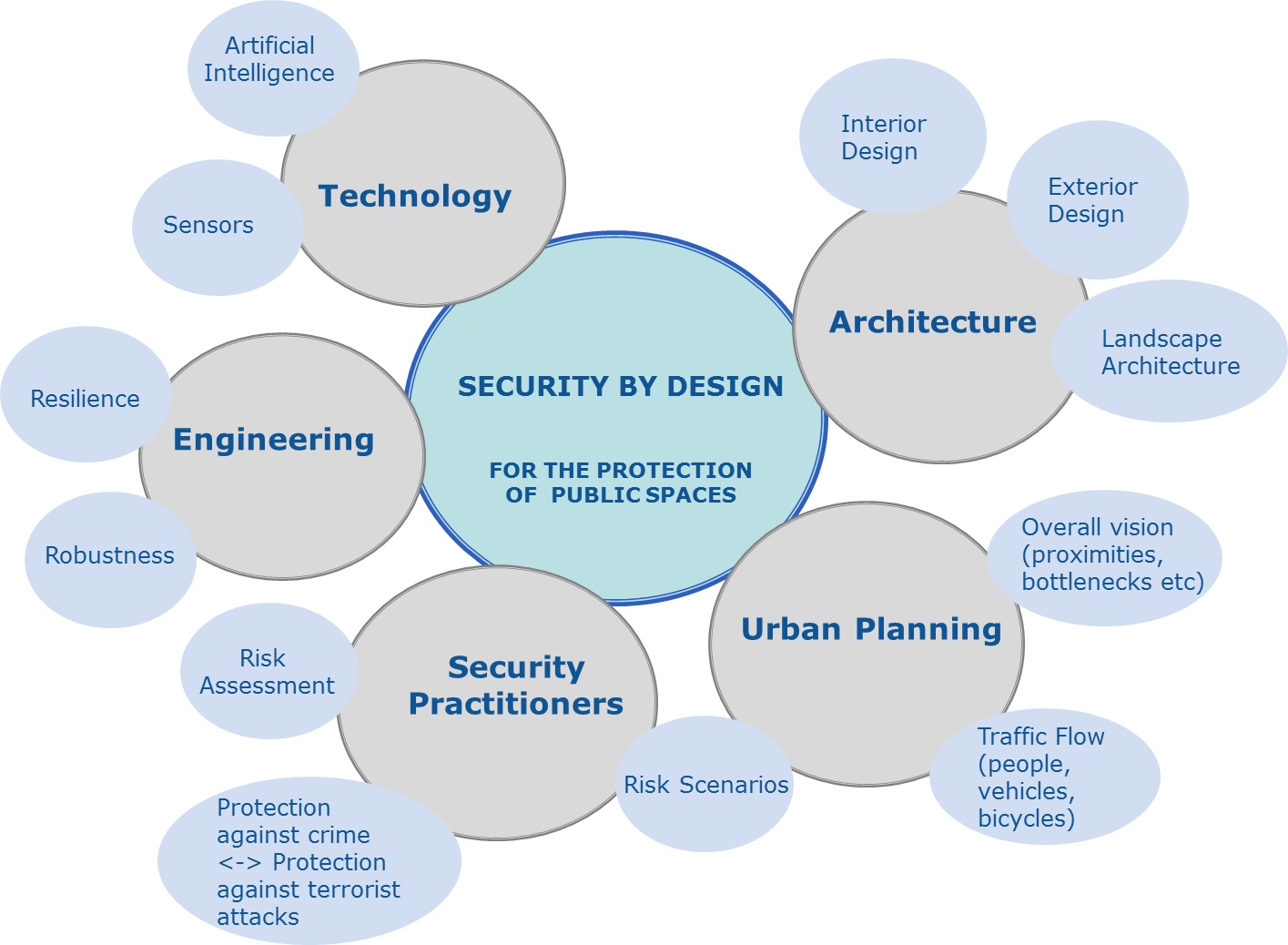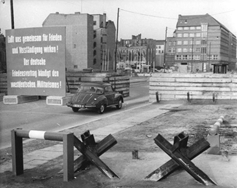Security by design for the Protection of Public Spaces

date: 24/06/2019
Terrorist attacks and other malicious acts often target public spaces and other unguarded areas (soft targets), like city centres, pedestrian precincts, transport hubs, shopping malls, parks, bars and restaurants. Due to their open nature, public spaces are characterized by large public attendance and may become an easy target for not particularly sophisticated or costly methods. Attacks against public spaces constitute a violent assault on our daily lives, resulting in loss of human life, negative impact on the local economy, loss of confidence by the public towards established democratic institutions and longer-term consequences on the very functioning of our society.
Public spaces are innumerable and come in many different forms depending on their purpose, their location and their set-up within the urban landscape. Their protection poses great challenges to local law enforcement units, urban authorities and operators, in both technical and logistic terms. An important feature of the protection of public places is achieving the right balance between effective protection and people’s individual and collective fundamental rights[1]. According to the Council conclusions on the development of a renewed EU Internal Security Strategy, 'respecting fundamental rights in planning and implementing internal security policies and actions has to be seen as a means of ensuring proportionality, and as a tool for gaining citizens’ trust and participation'[2]. Protecting our public spaces does not mean turning our cities into fortresses, but rather incorporating seamlessly, wherever possible, the measures of protection within the aesthetics of the urban landscape.
A lot can be done to deter and mitigate the impact of terrorist attacks, while maintaining the attractiveness and openness of our cities. Under the European Commission's 'Action Plan to Support the Protection of Public Spaces'[3], there are various initiatives for promoting the exchange of best practices, networks creation, funding of security-related projects and publication of guidance material. These initiatives have further reinforced the realization that security is best achieved if addressed from the very beginning of the planning and design of a public space – a concept commonly referred to as security by design in the protection of public spaces.
To develop public spaces in a security by design framework, potential malicious attack scenarios and the project’s vulnerabilities have to be assessed and addressed from the very onset of the planning and design process, hand in hand with considerations of aesthetics, liveability, use, safety, management etc. When compared with ad-hoc solutions installed at a later stage, security measures that are conceived from the initial stages of the design process are less likely to conflict with existing services and utilities and they can be better integrated within the surrounding environment.
Table 1 Security by Design vs Ad-Hoc Security Solutions
Security by Design |
Ad-Hoc Security Solutions |
|
|
|
|
Efficiency |
|
|
The project is more efficient as it is designed considering security aspects from its initial design stages. Depending on the project, this may involve modifications in the interior and exterior design, alteration and addition of access points, ensuring structural robustness, introduction of perimeter protection measures, redesign of the surrounding terrain etc. |
Ad-hoc solutions are less efficient as they, usually, cannot address multiple threats and it is difficult to integrate them in the overall protective design. |
|
Installation |
|
|
Security measures are incorporated in the overall urban design project and they are less likely to conflict with existing services and utilities (e.g. gas, water, electricity, telecommunication lines). Costly and time consuming diversions are avoided. |
Ad-hoc security measures are more likely to conflict with existing services and utilities as they are usually stand-alone projects and may lead to costly service diversions, cut off of utilities for residents and slower project implementation |
|
Vulnerability |
|
|
Various potential attack scenarios are assessed taking in consideration not only the project's particular features but also its positioning within the overall urban context (e.g. proximity to other crowded places, creation of bottlenecks, shifting of the flow of people). The creation of additional vulnerabilities is prevented as such effects are addressed in the planning. |
The adoption of ad-hoc solutions may create additional vulnerabilities or shift vulnerabilities to other public spaces as the installed measures are usually not examined in a holistic manner. |
|
Cost |
|
|
The adoption of security measures as part of an overall urban design project can reduce the costs of protective solutions substantially as planning the protective measure is advance allows for resourcefulness, multifunctionality and cost-efficiency |
Introducing ad-hoc security measures into an already built environment is generally more costly, as there are fewer available options that conform to the needs of the proprietors. |
|
Aesthetics |
|
|
The security by design concept guarantees that security measures are harmonically integrated into the urban environment, as they are part of a protective urban development project. |
The integration of ad-hoc solutions into the urban environment is more challenging and may lead to questionable results as they frequently do not blend in with the existing design characteristics. |
To achieve the integration of security into public spaces, architects, engineers, urban planners and security advisers have to work together during all phases of the planning and design process of a public space project. Planners need to consider multi-hazard approaches, assess potential attack scenarios and adopt the concepts of resilience and robustness especially for building structures. Security measures can be embedded into innovative architectural and artistic concepts. Contextual design can help to integrate protection into the urban landscape. Technological solutions, involving sensors, CCTV’s and artificial intelligence features can give additional security layers that may be also effective against emerging new threats.

Chart 1: Actors and roles for the security by design concept of public spaces
Applying security by design for the Protection of Public Spaces
The implementation of the security by design concept and the development of an appropriate protective strategy call for a vulnerability assessment of the site as well as analysis of potential attack scenarios and their consequences if executed. A scenario-based approach at potential targets serves to channel the complexity of the vulnerability assessment process. A site survey is important to pinpoint existing vulnerabilities and viable attack routes. Of course, the probability of occurrence of a terrorist attack is difficult to be calculated as it is also dependent on temporal circumstances (high profile events, attendance, religious or political motivations of the aggressors, momentary state of mind of the attacker etc.) and, in many cases, it is of opportunistic character. Indeed, decision makers will have to accept a certain level of risk as providing protection against all possible threats is not feasible in both economic and practical terms. The definition of the acceptable risk is an important part of the security assessment procedures.
How does the European Commission promote the security by design principle
The European Commission offers guidance material, provides fora and establishes networks for the exchange of best practice and lessons learnt, it grants funding opportunities for research and development projects in the field and creates, manages and disseminates knowledge in a holistic, multidisciplinary manner. The Commission is also at the forefront of evaluating the possibilities and promoting the creation of standards, for example related to the testing of security elements like windows, barriers and general standards for building and material design.
Table 2: Examples of concrete steps by the European Commission on the promotion of security by design for the protection of public spaces
| Guidance material
|
Guideline for selecting proper security barriers Guidance document on the design, testing and installation procedures of barriers for the protection of public spaces against malicious attacks with the use of vehicles.
Policy report on soft target / public space protection providing available information sources focusing on the protection of the so-called soft targets against terrorism attacks.
Guideline on the calculation of blast Loads for application to structural components describing a procedure to be followed for the calculation of loads to be applied on structures as a consequence of a blast at a building’s exterior (Vehicle-borne and/or person-borne explosives).
Guideline for the protection of buildings (to be published) Scientifically based guideline for hands-on solutions to be used by actors related to public space protection. Topics covered for different types of buildings and considering scenarios of attacks with different modus operandi (for example, perimeter protection against illicit access, protection of the façade (also against explosive drones), protection against progressive collapse, access points).
Guidelines for specific operators (to be published) Guidance material addressing the needs of specific operator groups (e.g. event managers, shopping centres administrators, car rental offices etc.).
Guideline for risk-dependent interior design of public spaces A guideline displaying good practices and technical solutions to be applied within a building to physically protects occupants and assets from man-made hazards. The proposed measures should minimize disturbance to business and other performed activities.
|
| Networks for the exchange of best practice and dissemination of information |
Continuation, expansion and enhancement of established networks with stakeholders from urban administrations, security operators, researchers and industry (operators' workshop). |
| Provide funding |
Provide funding through the Internal Security Fund (ISF) and H2020 for research projects and concrete actions that include a wide range of initiatives, such as prevention, preparedness and innovative measures for the protection of public spaces. Follow up of funded projects, impact assessment and dissemination of results
|
| Develop vulnerability assessment tools for the protection of public spaces
|
Develop specialized vulnerability tools for different target groups, such as for city centres, public buildings and critical infrastructures |
| Training for local authorities |
A dedicated training for local authorities for the protection of cities has been provided in the JRC-Ispra, Italy in June 2019. A training concerning building perimeter protection is planned for the end of 2019 in Brussels, Belgium. Different training format are planned, catering for a broad range of operator-specific needs
|
| Standardization |
- JRC is involved in the standardization of the testing of blast loaded windows (CEN TC 33 WG1). - JRC is providing technical advice on the replacement of IWA 14 by a new ISO standard that covers the testing of barriers against vehicle ramming. - JRC collaborates with the International Federation for Structural Concrete (Fib), Action Group 12 'Impact & Explosion' with the scope of improving and implementing new design approaches for buildings (i.e. airports, shopping malls, sport centres and stadiums, etc.) subjected to blast and impact (i.e. induced by vehicles, trains, etc.). The envisaged development is intended to result into an internationally recognized and comprehensive fib Model Code 2020 for new and existing buildings.
|
| Information Material
|
Articles on the Commission's Protection of Public Spaces Newsletter
|
If you would like to receive additional information regarding the subjects in this article, please contact JRC-PUBLIC-SPACES@ec.europa.eu


